Posted by Anita on 12.31.09 11:38 AM
 It’s the last day of 2009, and your last chance to bid in the Menu for Hope raffle. Pim’s added a handy form that tallies up your bid items and fills out the Firstgiving form for you — it’s so easy, you can even do it with a glass of Champagne in one hand!
It’s the last day of 2009, and your last chance to bid in the Menu for Hope raffle. Pim’s added a handy form that tallies up your bid items and fills out the Firstgiving form for you — it’s so easy, you can even do it with a glass of Champagne in one hand!
She’s also flagged “hot” and “cold” items, so you have an inkling of how good your odds are of winning a given bid item. (You still have pretty good chances on our Locavore Starter Kit, by the way.) Oh, and there are a few newly added goodies, like a coffee date with Ruth Reichl, gardening classes at Love Apple Farm, and a 1/2-pound box of top-quality black truffles. Check it out over at Pim’s site.
Happy new year’s eve to everyone, and don’t forget to look up in the sky: Tonight’s going to be a blue moon. May your new year be filled with many rare and beautiful sights!
giving back, holidays & occasions, Menu for Hope
1 Comment »




Posted by Anita on 12.27.09 11:37 AM
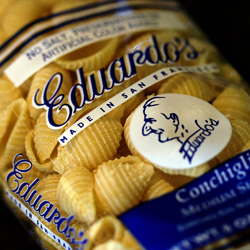 I don’t know what it’s like at your house, but holiday weeks around here can be a little nuts. Even if we don’t have a gaggle of family in residence, there’s always some last-minute preparation, either for a landmark meal, a potluck contribution, or an impending trip.
I don’t know what it’s like at your house, but holiday weeks around here can be a little nuts. Even if we don’t have a gaggle of family in residence, there’s always some last-minute preparation, either for a landmark meal, a potluck contribution, or an impending trip.
This year, it was the latter — we’re off to Seattle for the week after Christmas — so when planning our dinners, we wrestled with the extra complication of creating leftover-free meals. Pasta’s always a simple, comforting for Dark Days Challenge meals, but neither of us was really in the mood for our weekly dose of bolognese.
This recipe reminds me a bit of the Pasta e Fagioli with ‘Nduja that’s become a standard in our kitchen: It comes together in a snap, and it’s far more delicious than a simple reading of the ingredients would suggest. But in place of the beans, this version has leafy broccoli (either broccoli raab or broccoli di ciccio work) and the sausage stays crumbly, rather than melting alluringly into the sauce. Any small pasta will do, but I like shells or ear-shaped orecchiette, which catch bits of the sauce in their cups.
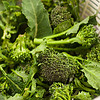
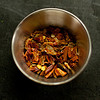
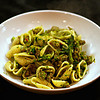


Pasta with Leafy Broccoli and Sausage
— adapted from Kitchen Sense
1/2 to 3/4 pound leafy broccoli (broccoli rabe or broccoli di ciccio)
6 to 8oz small pasta shells or orecchiette
1/4 cup olive oil
1 small white or yellow onion, chopped
3 garlic cloves, minced
a generous pinch of red pepper flakes
1T chopped parsley
1/2 pound mild Italian sausage, removed from casings
freshly grated Parmesan-style cheese
Bring 4 quarts of well-salted water to a hard boil. Meanwhile, trim the tough ends from the broccoli, and cut into 1-inch pieces. (You’ll want to split the florets lengthwise if you’re using di ciccio.) Add the pasta to the water and cook until it’s just beginning to soften, about 4 minutes. Add the broccoli pieces and continue to cook until the pasta is al dente. Reserve about half a cup of the cooking water, then drain the pasta well.
While the pasta cooks, saute the sausage meat in a large skillet over medium heat, breaking into small pieces. When browned. remove to a plate using a slotted spoon, and set aside. Add enough olive oil to generously coat the pan (the amount will vary depending on how much rendered fat you got out of your sausage). Add the onion and sweat until soft; do not brown. Add the garlic and the pepper, and cook until softened.
Add the drained pasta/broccoli to the skillet, along with about 1/4 cup of the cooking liquid. Toss the pasta, adding another 2T of olive oil, or as needed to coat the pasta thoroughly. Add the parsley and more of the cooking liquid if needed to give the dish a sauced appearance.
Serve in wide bowls, scattered with grated Parmesan-style cheese. Makes 2 to 3 main-course servings.
Farmers and food artisans who created the ingredients for this week’s meal: 
Heirloom Organic Farm, Hollister: broccoli di ciccio
Eduardo’s, San Francisco: pasta shells
Bariani, Sacramento: olive oil
Catalán Family Farm, Hollister: onions
Iacopi, Half Moon Bay: garlic
Tierra Vegatables, Santa Rosa: crushed red pepper
Mariquita Farm, Watsonville: parsley
Fatted Calf, Napa: Calabrese sausage
Vella Cheese, Sonoma: dry Jack cheese
Dark Days challenge, locavore
4 Comments »




Posted by Anita on 12.24.09 3:54 PM
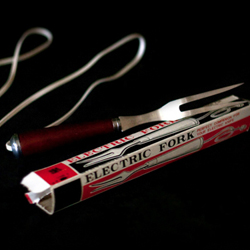 Merry Christmas to all! Hope you have a lot of delicious treats in store over the long weekend.
Merry Christmas to all! Hope you have a lot of delicious treats in store over the long weekend.
You probably have an electric knife — heck, you might even be hauling it out to carve your Christmas ham or prime rib — but I bet you don’t have an electric fork.
Think you might need one? Check out my guest post today on The Kitchn, Apartment Therapy’s food site, for the story of my family’s silly holiday tradition.
family, levity, other blogs
5 Comments »




Posted by Anita on 12.20.09 10:31 PM
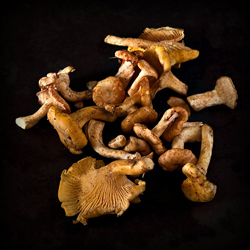 I’m not entirely sure why we haven’t made Miss Lewis’s pork shoulder — a recipe that we’ve swooned over, even declared good enough for company — in an awfully long while. My guess is that it’s because we’re being too picky. You see, we used to be able to reliably source skin-on pork shoulder, but it’s become harder to find, even as we get better and better at finding local pork. And as much as we love the salty, shattering cracking that we’re able to make when we manage to get our hands on a perfect specimen, we really should remember how satisfying this recipe can be, even without its crispy accompaniment.
I’m not entirely sure why we haven’t made Miss Lewis’s pork shoulder — a recipe that we’ve swooned over, even declared good enough for company — in an awfully long while. My guess is that it’s because we’re being too picky. You see, we used to be able to reliably source skin-on pork shoulder, but it’s become harder to find, even as we get better and better at finding local pork. And as much as we love the salty, shattering cracking that we’re able to make when we manage to get our hands on a perfect specimen, we really should remember how satisfying this recipe can be, even without its crispy accompaniment.
This recipe, which came our way via Southern food maven Edna Lewis, is a kissing cousin of our favorite Zuni mock porchetta, but with a deep, lip-smacking sauce that’s perfect for cooler weather. And where porchetta needs little adornment other than the vegetables roasted alongside the pork, its American doppelganger cozies up nicely to mashed potatoes or — even more appropriately — a puddle of creamy grits.
Speaking of which, we took a few liberties for this week’s Dark Days Challenge meal. Although we’ve got a few sources for cornmeal here in the Bay Area, we’re still grits-less. Happily, our friend Kristina of Tennesee Locavore brought us a bag of her favorite local grits as a hostess gift during the BlogHer Food conference. Much like Jeanne’s cranberries, we’re counting this hand-carried gift as an honorary local staple. But everything else in the pan and on the plate was readily found within our 100-mile radius.


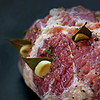
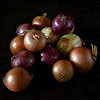
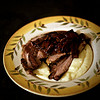
Bay-Studded Pork Shoulder with Wild Mushroom Sauce
– adapted from The Gift of Southern Cooking
1 pork shoulder, preferably bone-in and skin-on
1-1/2 tsp salt
1-1/2 tsp cracked peppercorns
1-1/2 tsp dried thyme
3 cloves garlic, peeled and thinly sliced lengthwise
12 whole, small bay leaves
1 onions, peeled and thickly sliced
up to 1 bottle red wine (or half wine and half port)
—
2T unsalted butter
2C mixed wild mushrooms
salt and pepper
1 shallot, minced
2 small cloves garlic, minced
2T finely minced parsley
1/2 cup heavy cream
The night before, or at least 3 hours before cooking, rinse and dry the pork shoulder. Cut twelve equally-spaced slits in the skin side of the meat, about 1 inch deep and 1-1/2 inches deep. Mix together the salt, pepper, and thyme, and pinch a bit into each slit, followed by a garlic slice and a bay leaf. (The leaves will stick out above the surface of the meat, making them easy to remove after cooking.) Rub the remaining seasoning on the meat, cover loosely and refrigerate.
About an hour before cooking, bring the pork to room temperature. Preheat the oven to 325°F. Place the onion slices on the bottom of a shallow roasting pan or baking dish just large enough to hold the roast. Top with the prepared pork shoulder, then pour the wine into the bottom of the pan, enough to come about halfway up (but not immerse) the pork. Lay a piece of parchment over the pork, then wrap the entire pan tightly with heavy-duty foil (or a double thickness of regular foil). Braise for 4-1/2 to 5 hours, until the meat is very tender.
While the pork is roasting, clean the mushrooms and cut into 1/3-inch slices.
When the pork is finished, remove from the oven. Place the meat on a platter or cutting board and set aside in a warm place. Remove the bay leaves from the pork and discard. Strain the braising liquid, discarding the onions and other solids, and skim most of the fat. (If you’re lucky enough to have found a skin-on pork shoulder, remove the skin at this point and finish the crackling in a very hot oven while you make the sauce.)
Heat the butter in a large skillet until foaming subsides. Add mushrooms and cook over medium-high heat, stirring as needed, until just beginning to brown. Season with salt and pepper; add the shallot, garlic, and parsley and saute, taking care not to overbrown the aromatics. Pour in the strained and defatted braising liquid and boil over high heat until reduced to a syrupy consistency. Reduce heat to medium and add the heavy cream and simmer until heated through. Adjust seasoning to taste.
To serve, slice the pork shoulder thinly against the grain; serve with a piece of crackling on the side and the mushroom sauce spooned over the meat.
Farmers and food artisans who created the ingredients for this week’s meal: 
Marin Sun Farms, Point Reyes: pork shoulder
Guisto’s Vita-Grain, South San Francisco: sea salt
Iacopi, Half Moon Bay: garlic
Spring Hill Cheese Company, Petaluma: butter
Dirty Girl Produce, Santa Cruz: shallot
Mariquita Farm, Watsonville: parsley
Straus Creamery, Petaluma: cream
Catalán Family Farm, Hollister: onions
Walter Hansel Winery, Russian River Valley: wine
Far West Fungi, Moss Landing: chanterelle and yellowfoot mushrooms
…and our own homegrown bay leaves and thyme
Exemptions: black pepper, grits
Dark Days challenge, locavore, recipes
9 Comments »




Posted by Anita on 12.14.09 8:00 AM

For two weeks each December, bloggers from all over the world offer a delectable array of food-related items for the Menu for Hope raffle. Last year, we raised $62,806 to help the UN World Food Programme feed the hungry. This year, we’re supporting a new initiative at the WFP called Purchase for Progress (P4P), which enables smallholder and low-income farmers to supply food to WFP’s global operation.
This year’s campaign runs December 14 to 25, and every $10 you donate earns you one virtual raffle ticket for the item of your choice. (To learn more, head over to Chez Pim and check out her Menu for Hope FAQ, or read the highlights at the bottom of this post.)
This year, we’re offering the following item, also focused on supporting small, local farms:
Bid Item UW02: Locavore Starter Kit
Many readers tell us that they’d love to eat more local foods, but they don’t know where to start. So we’re making it simple with a Locavore Starter Kit: A trial membership to the Soul Food Farm chicken-and-egg CSA (or another CSA of your choice* if you live outside the Bay Area) and a farmer’s market tour with breakfast and local treats.
- Soul Food Farm and Married …with Dinner are offering a $100 CSA credit toward the winner’s choice of whole chickens, eggs, olive oil, and other farm-fresh goodies. Pick up your winnings all at once, or spread it over multiple pickups: It’s up to you how to spend your CSA credit (subject to the usual order terms).
- Plus, Soul Food Farm farmer Alexis Koefoed offers a personal tour of Soul Food Farm for the winner and up to 3 guests at a mutually agreeable time in 2010.
- We’ll also include a personalized tour of the San Francisco Ferry Plaza Farmers Market, complete with breakfast or lunch for two, to help our winner find all the great foods they need to make the leap to la vida locavore.
- And if that’s not enough, we’ll also bring along a bag full of local treats and homemade goodies for you to take home after your walk-around. The bag will include some of our own preserves, and an assortment of treats from local folks — including a bag of brown rice and a jar of almond butter from Massa Organics.
* A special note for non-Bay Area bidders: If the winner’s residence is not located within 25 miles of a Soul Food Farm drop point, we’ll pay the first month’s box charges ($50 maximum) for any Community Supported Agriculture program in the winner’s area. And the market tour + breakfast portion is open to any winner, local or visitor, on any Saturday in 2010 (subject to Anita & Cameron’s availability). We can ship the goodie bag, but the winner would be responsible for all postage and packing charges.
To donate and enter the Menu for Hope raffle: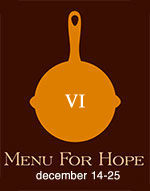
1. Choose bid item(s) from the main Menu for Hope list.
2. Visit the Firstgiving Menu for Hope page; make a donation.
3. Please specify which bid item(s) you’d like in the ‘Personal Message’ section of the donation form. You must write in how many tickets per bid item; please use the bid-item code. Each $10 you donate will give you one raffle ticket. For example, a donation of $50 can be 2 tickets for UW01 and 3 tickets for UW02 (written as 2xUW01, 3xUW02). The code for our Locavore Starter Kit is UW02.
4. If your company matches your charity donation, please check the box and fill in the information so Menu for Hope can claim the corporate match.
5. Please allow us to see your email address so that we can contact you in case you win. (Don’t check the box to keep your address private). Your email address will not be shared with anyone.
Check back here on Monday, January 18, for the results of the raffle. Good luck to everyone, and thanks for supporting such a worthy cause!
farms & farmers, giving back, locavore, Menu for Hope
7 Comments »




Posted by Anita on 12.13.09 1:21 PM
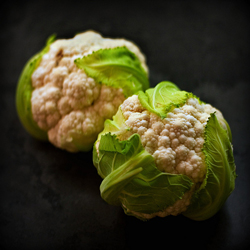 I like to think of myself as a spontaneous person, but I can be… shall we say “resistant”?… to last-minute changes. I’m trying to change, to become a little more flexible, and when I break out of my best-laid plans, oftentimes I’m rewarded.
I like to think of myself as a spontaneous person, but I can be… shall we say “resistant”?… to last-minute changes. I’m trying to change, to become a little more flexible, and when I break out of my best-laid plans, oftentimes I’m rewarded.
A case in point: On Monday, I made a delicious-sounding braised brisket from the October issue of Gourmet. I’d been thinking all weekend about how I would document the recipe for this week’s Dark Days Challenge meal. I planned photos, even brainstormed ideas describing brisket as the perfect braise for chilly autumn.
But although the brisket itself cooked up to a melting perfection (and the ingredients made for some pretty pictures) the sauce was too tomato-y and sweet, a rather one-dimensional result. Definitely not the sort of recipe I like to share with you here. Luckily, we had a pantry and fridge full of other local options, and another few day’s worth of possibilities before the weekly roundup. It took us until Friday night to find a recipe worth sharing, but oh was it worth the wait.
I’ve started collecting chicken recipes in an effort to keep our weekly CSA deliveries from becoming too mundane. No matter how much we love roast chicken (and love it we do) it’s hard for me to work up enthusiasm, week in and week out, for even the most perfectly golden bird. We’ve got a nice little rotation going: Pan-seared, braised, pot pies, jambalaya, coq au vin — it’s all good. But we’re always on the lookout for new ideas to keep things fresh.
When I came across this recipe in one of my favorite cookbooks, I couldn’t even remember the last time I’d made chicken paprikash. I vaguely recalled a version made with boneless, skinless chicken breasts and low-fat sour cream from my deluded college years. But as we prepped the ingredients, it became increasingly clear that this hearty braise was nothing like the over-stewed, excessively tart rendition of my youth.
Tempted by the rich, spicy smells we’d endured for close to an hour, we dove into our meals. Silence descended on the table, broken only by “wow”s and “mmm”s. As he polished off the last bite, Cameron looked me in the eye and said: “That is definitely a keeper.” I was too busy licking my plate to disagree.
Maybe it’s the quick dredge in flour that gives the sauce a silky texture. Maybe it’s browning the meat in bacon drippings — never a bad idea when it comes to flavor. Maybe it’s the addition of fresh frying peppers, alongside the usual dried paprika. Or maybe it’s the rich swirl of crème fraiche at the end, instead of garden-variety sour cream. Whatever the reason, this particular version transcends the genre’s often-lackluster norm.
There’s just one small problem: Like most braises, even the world’s most delicious chicken paprikash looks like a pile of mush. Which explains why you’re looking at the beautiful Swanton cauliflower that we served alongside our brown, lumpy main course. Our first of the year, each head was the size of a softball at most, and mineral-y sweet. Instead of steaming it as we usually do, we quick-braised the florets in a shallow pan; I’m more convinced than ever that just about every vegetable tastes amazing cooked this way.
If I were making this meal over again — especially if I were planning on photographing it — I might choose a green vegetable for a side dish. But honestly, I don’t know how we could have enjoyed it any more.


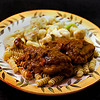


Chicken Paprikash
– adapted from Kitchen Sense
a 4- to 4.5-pound chicken, cut into 10 even pieces
2T oil
2T bacon fat, lard, or additional oil
1/2 cup all-purpose flour
1 medium onion, chopped
1 large garlic clove, minced
1 large or 2 large small Italian frying peppers, seeded and chopped
2T sweet Hungarian paprika (or a mix of sweet + hot)
1 cup chicken stock
1/2 cup white wine
1 large ripe tomato, peeled and cut into chunks, or 2 canned/frozen tomatoes, cut up
1/2 cup crème fraiche or sour cream
Rinse the chicken parts in cold water, and pat dry. Generously season the pieces with salt and pepper.
Heat the oil and bacon fat in a dutch oven or other heavy, wide pot over medium-high heat. Dredge the chicken in flour, shaking off any excess, and place each piece in the hot fat, skin side down. Fry the chicken, turning as needed, until golden brown on all sides. Remove the chicken to a clean plate and keep warm near the stove.
Reduce heat to medium. Add the onion and garlic and cook until soft but not brown. Add the peppers and continue to cook until soft. Add the paprika and cook for a minute or two until you smell the spice; do not brown or it will turn bitter. Add the stock, wine, and tomato and stir well. Return the chicken to the pot, along with any juices from the plate, and nestle into the vegetable mixture; sauce should come about halfway up each piece.
Cover the pot, reduce the heat to low, and simmer for 30 minutes, stirring occasionally. Remove the cover and simmer until the cooking liquid has reduced by about half and the chicken starts to pull away from the leg bones, about an additional 20 minutes. When chicken is done, remove it to a clean plate. Remove the pot from the heat, and stir in the crème fraiche or sour cream. Taste and adjust seasoning as needed.
Serve the chicken over buttered noodles or spätzle, then top each portion with sauce.
Farmers and food artisans who created the ingredients for this week’s meal: 
Soul Food Farm, Vacaville: chicken
Bariani, Sacramento: Olive oil
Guisto’s Vita-Grain, South San Francisco: flour, sea salt(!)
Catalán Family Farm, Hollister: onions & garlic
Happy Quail Farm, East Palo Alto: frying peppers
Walter Hansel Winery, Russian River Valley: wine
Bellwether Farms, Sonoma: crème fraiche
Eduardo’s, San Francisco: pasta
Swanton Berry Farm, Davenport: cauliflower
…and our own home-cured bacon (rendered for fat), home-canned chicken stock, and homegrown tomatoes
Exemptions: paprika, black pepper
Dark Days challenge, locavore, recipes
6 Comments »




Posted by Anita on 12.06.09 1:49 PM
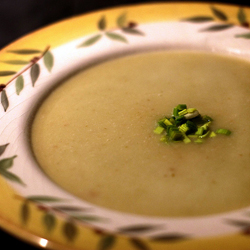 Some weeks — in fact, pretty much every week, if I’m being honest — I spend an hour or two each Friday night planning out the next seven days’ meals. I comb through the fridge and make a list of all the bits and pieces that didn’t get used up from the last market trip. Then I build a week’s menus based on what needs to get used up, and what we’re both craving. I almost always leave one or two dinners open either to market inspiration, or spontaneous (read: laziness-induced) dining out.
Some weeks — in fact, pretty much every week, if I’m being honest — I spend an hour or two each Friday night planning out the next seven days’ meals. I comb through the fridge and make a list of all the bits and pieces that didn’t get used up from the last market trip. Then I build a week’s menus based on what needs to get used up, and what we’re both craving. I almost always leave one or two dinners open either to market inspiration, or spontaneous (read: laziness-induced) dining out.
The only problem with this scheme is that sometimes we find ourselves at home without anything planned for dinner. Usually we’re content with something from the freezer — planned leftovers of stew, chili, or other easy-keeping meals — but this week we still had lots and lots of produce left from our last Mariquita Mystery Box delivery.
A big bunch of baby leeks and a handful of French red fingerling potatoes seemed like the natural base for a hearty, late-fall soup. I’ve made potato-leek soup before, but this version — where a small amount of bacon gets pureed into the base of the soup, rather than scattered on top — is now my all-time favorite. I can neither confirm nor deny that I ate two full bowls of the velvety, smokey stuff. Served with nothing more than a bowl of chilled radishes alongside and a scattering of the season’s first green garlic on top, it made for a perfect impromptu supper.
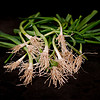




Potato-Leek Soup
adapted from Emeril Lagasse
1 pound leeks
2 bay leaves
20 black peppercorns
4 sprigs fresh thyme
2 T butter
2 strips bacon, chopped
1/2 cup dry white wine
5 cups chicken stock
1 pound starchy potatoes, peeled and diced
1-1/2 tsp salt
1/4 tsp white pepper
1/2 cup cream
2 T finely minced green garlic, chives, or tender leek greens
Tie together bay leaves, peppercorns and thyme into a cheesecloth bundle or infusing ball. Cut the white part of the leeks lengthwise and rinse well under cold water. Slice crosswise and set aside. Discard the greens, or save for making stock.
In a large saucepan, melt the butter over medium heat; when melted, add the bacon. Cook, stirring occasionally, until the bacon is soft and has rendered most of its fat; do not brown. Add the chopped leeks and cook until softened, about 5 minutes. Add the wine and bring to a boil. Add bouquet garni, chicken stock, potatoes, salt, and white pepper, and return to a boil. Reduce the heat to a simmer and cook for 30 minutes, or until the potatoes are falling apart.
Remove the bouquet garni and puree the soup with an immersion blender (or in batches — carefully — in a standard blender; then return to pan). Stir in the cream and adjust seasoning. Serve immediately, with minced chives or green garlic sprinkled over each bowl.
Farmers and food artisans who created the ingredients for this week’s meal: 
Mariquita Farm, Watsonville: potatoes, baby leeks
Spring Hill Cheese Company, Petaluma: butter
Clover Organic, Petaluma: cream
Page Wine Cellars, Napa: wine
Tairwa Knoll Farms, Brentwood: green garlic
…plus homegrown thyme & bay leaves; home-canned chicken stock; home-cured bacon
Exemptions: Salt, pepper
Dark Days challenge, locavore, recipes
5 Comments »




Posted by Anita on 12.04.09 10:34 AM

Every time we used to go to Alameda’s Forbidden Island, we sighed and wondered what it would take to convince its proprietor, Martin Cate, to open a bar like this closer to our house. It took a while, but our rum-soaked dreams have come true.
If anything, Smuggler’s Cove may turn out to be even more amazing than its East Bay cousin. Sure, there’s no outdoor patio (but really, given the shortage of sunny San Francisco days, I doubt we’d miss it), and the small space has the potential to get awfully crowded. But that wasn’t the case at last night’s media preview, where a handful of cocktail writers got the chance to sample five drinks out of the 80-plus offerings that the bar will serve come next Tuesday’s opening night.
What sets Smuggler’s Cove apart from the tiki pack is its focus on top-notch bartending talent (Martin’s gathered an enviable collection of West Coast heavy hitters), quality ingredients, and solid technique. It’s a serious rum-focused bar with retro-tropical decor, but there’s refreshingly little of the tongue-in-cheek cheesiness that you might expect. (Don’t get me wrong, I love me some ooga-booga. But I like a well-made, properly measured cocktail even more.)
And speaking of well-made cocktails, there were many to sample last night. A favorite of many guests, the Chadburn — rum, tawny port, pear liqueur, and a dash of Xocolatl Mole Bitters — takes its name from the gizmo that telegraphs changes in speed from the ship’s bridge to the engine room. The Hotel Nacional Special, which made its debut in 1939’s Gentleman’s Companion, combines pineapple, silver rum, apricot liqueur, and lime. Three more drinks — the frothy Cora Middleton, a spicy Three Dots and a Dash highball, and the island standby of J Wray & Ting — rounded out the night’s abbreviated menu.
The space itself is a marvel. The main level features a one-man bar that’s as snug and seemingly as well-designed as a yacht, surrounded by a handful of barstools and two walls of rum, rum, and more rum (and a few select spirits). Overlooking the main bar, an inviting balcony area — decorated with the requisite thatch walls and colorful puffer-fish and net-float lights — clusters armchairs around tables made to resemble old rum crates. Down a flight of ship-like stairs, a larger bar — comfortable enough for two shakers and a barback — boasts an even-larger array of rums. A low-ceilinged sitting area manages to feel cozy rather than claustrophobic, in part due to a two-story water feature that rises back to the entry.
A series of sold-out friends-and-family preview nights are scheduled for this weekend, with opening night slated for next Tuesday, December 8. It’s sure to be difficult to get a seat for weeks to come, but I know that once the crowds die down a bit, we’ll be dropping anchor in this cove quite often.
Smuggler’s Cove
650 Gough Street
San Francisco, CA 94102
415.869.1900
bar culture, drinks
8 Comments »




 It’s the last day of 2009, and your last chance to bid in the Menu for Hope raffle. Pim’s added a handy form that tallies up your bid items and fills out the Firstgiving form for you — it’s so easy, you can even do it with a glass of Champagne in one hand!
It’s the last day of 2009, and your last chance to bid in the Menu for Hope raffle. Pim’s added a handy form that tallies up your bid items and fills out the Firstgiving form for you — it’s so easy, you can even do it with a glass of Champagne in one hand!































